Documentation
Duo Two-Factor Authentication for NetMotion Mobility
Last Updated: September 19th, 2023Contents
Duo integrates with your NetMotion Mobility VPN software to add two-factor authentication to any VPN login.
Overview
Duo two-factor authentication for NetMotion supports using the EAP (PEAP-GTC) mechanism against a RADIUS server using Duo's Authentication Proxy radius_client primary authentication or against an Active Directory domain controller using ad_client primary authentication. If you are not using Active Directory and do not have a RADIUS server that supports EAP you must deploy one (for example, Microsoft Network Policy Server or FreeRADIUS) before using Duo authentication. If using RADIUS as the primary authenticator with NetMotion EAP, the RADIUS server must permit use of PAP encryption.
You will need a certificate and corresponding key file when configuring the Duo Authentication Proxy. The key file must not be encrypted nor can it require a password for use. The certificate can be issued by a trusted certificate authority (CA) or self-signed. If you'd like to use a self-signed certificate, you can create one using OpenSSL following the example instructions here. If you have enabled the "Validate server certificate" option on your NetMotion Mobility clients, then you must use a certificate issued by a CA that your Mobility client systems trust.
This configuration doesn't support inline self-service enrollment. You'll need to create your users in Duo ahead of time using one of our other enrollment methods, like directory sync or CSV import. Read the enrollment documentation to learn more.
This application communicates with Duo's service on SSL TCP port 443.
Firewall configurations that restrict outbound access to Duo's service with rules using destination IP addresses or IP address ranges aren't recommended, since these may change over time to maintain our service's high availability. If your organization requires IP-based rules, please review Duo Knowledge Base article 1337.
Effective June 30, 2023, Duo no longer supports TLS 1.0 or 1.1 connections or insecure TLS/SSL cipher suites. See Duo Knowledge Base article 7546 for additional guidance.
First Steps
Before moving on to the deployment steps, it's a good idea to familiarize yourself with Duo administration concepts and features like options for applications, and Duo policy settings and how to apply them. You'll need to pre-enroll your users in Duo using one of our available methods before they can log in using this configuration. See all Duo Administrator documentation.
You should already have a working primary authentication configuration for your NetMotion VPN users before you begin to deploy Duo.
To integrate Duo with your NetMotion VPN, you will need to install a local Duo proxy service on a machine within your network. This Duo proxy server will receive incoming RADIUS requests from your NetMotion VPN, contact your existing local LDAP/AD or RADIUS server to perform primary authentication if necessary, and then contact Duo's cloud service for secondary authentication.
If you are already running a Duo Authentication Proxy server in your environment, you can use that existing host for additional applications, appending the new configuration sections to the current config. You don't have to set up a new Authentication Proxy server for each application you create. However, there are some cases where it might make sense for you to deploy a new proxy server for a new application, like if you want to co-locate the Duo proxy with the application it will protect in the same data center.
We recommend the following operating systems for the system hosting the Duo Authentication Proxy:
- Windows Server 2016 or later
- CentOS 7
- CentOS Stream 8 or later
- Fedora 37 or later
- Red Hat Enterprise Linux 7 or later
- Ubuntu 20.04 LTS or later
- Debian 11 or later
The Duo End of Sale, Last Date of Support, and End of Life Policy states that Duo does not offer support for integrations running on operating system versions beyond the vendor’s stated Last Date of Support date.
See detailed Authentication Proxy operating system performance recommendations in the Duo Authentication Proxy Reference.
We do not recommend installing the Duo Authentication Proxy on the same Windows server that acts as your Active Directory domain controller or one with the Network Policy Server (NPS) role. If you must co-locate the Duo Authentication Proxy with these services, be prepared to resolve potential LDAP or RADIUS port conflicts between the Duo service and your pre-existing services.
Then you'll need to:
- Sign up for a Duo account.
- Log in to the Duo Admin Panel and navigate to Applications.
- Click Protect an Application and locate the entry for NetMotion Mobility with a protection type of "2FA" in the applications list. Click Protect to get your integration key, secret key, and API hostname. You'll need this information to complete your setup. See Protecting Applications for more information about protecting applications in Duo and additional application options.
The security of your Duo application is tied to the security of your secret key (skey). Secure it as you would any sensitive credential. Don't share it with unauthorized individuals or email it to anyone under any circumstances!
Install the Duo Authentication Proxy
If you will reuse an existing Duo Authentication Proxy server for this new application, you can skip the install steps and go to Configure the Proxy.
The Duo Authentication Proxy can be installed on a physical or virtual host. We recommend a system with at least 1 CPU, 200 MB disk space, and 4 GB RAM (although 1 GB RAM is usually sufficient). See additional Authentication Proxy performance recommendations in the Duo Authentication Proxy Reference.
We do not recommend installing the Duo Authentication Proxy on the same Windows server that acts as your Active Directory domain controller or one with the Network Policy Server (NPS) role. If you must co-locate the Duo Authentication Proxy with these services, be prepared to resolve potential LDAP or RADIUS port conflicts between the Duo service and your pre-existing services.
- Download the most recent Authentication Proxy for Windows from https://dl.duosecurity.com/duoauthproxy-latest.exe. Note that the actual filename will reflect the version e.g. duoauthproxy-6.4.1.exe. View checksums for Duo downloads here.
- Launch the Authentication Proxy installer on the target Windows server as a user with administrator rights and follow the on-screen prompts.
When installing, you can choose whether or not you want to install the Proxy Manager. The Proxy Manager is a Windows utility that helps you edit the Duo Authentication Proxy configuration, determine the proxy's status, and start or stop the proxy service. Learn more about using the Proxy Manager. Installing the Proxy Manager adds about 100 MB to the installed size.
If you do not want to install the Proxy Manager, you may deselect it on the "Choose Components" installer screen before clicking Install.
To perform a silent install on Windows, issue the following from an elevated command prompt after downloading the installer (replacing version with the actual version you downloaded):
duoauthproxy-version.exe /SAppend /exclude-auth-proxy-manager to install silently without the Proxy Manager:
duoauthproxy-version.exe /S /exclude-auth-proxy-managerEnsure that Perl and a compiler toolchain are installed. On most recent RPM-based distributions — like Fedora, Red Hat Enterprise, and CentOS — you can install these by running (as root):
$ yum install gcc make libffi-devel perl zlib-devel diffutilsOn Debian-derived systems, install these dependencies by running (as root):
$ apt-get install build-essential libffi-dev perl zlib1g-devIf SELinux is present on your system and you want the Authentication Proxy installer to build and install its SELinux module, include
selinux-policy-develandchkconfigin the dependencies:$ yum install gcc make libffi-devel perl zlib-devel diffutils selinux-policy-devel chkconfig$ apt-get install build-essential libffi-dev perl zlib1g-dev selinux-policy-devel chkconfig-
Download the most recent Authentication Proxy for Unix from https://dl.duosecurity.com/duoauthproxy-latest-src.tgz. From the command line you can use
curlorwgetto download the file, like$ wget --content-disposition https://dl.duosecurity.com/duoauthproxy-latest-src.tgz. Depending on your download method, the actual filename may reflect the version e.g. duoauthproxy-6.4.1-src.tgz. View checksums for Duo downloads here. Extract the Authentication Proxy files and build it as follows:
$ tar xzf duoauthproxy-6.4.1-src.tgz $ cd duoauthproxy-version-src $ make-
Install the authentication proxy (as root):
$ cd duoauthproxy-build $ ./installFollow the prompts to complete the installation. The installer creates a user to run the proxy service and a group to own the log directory and files. You can accept the default user and group names or enter your own.
If SELinux is present on the target server, the Duo installer will ask you if you want to install the Authentication Proxy SELinux module. Your selection affects whether systemd can start the Authentication Proxy after installation.
SELinux Mode Default Response Result Enforcing Yes Choose 'yes' to install the Authentication Proxy's SELinux module. This permits start of the Authentication Proxy service by systemd. If you choose 'no' then the SELinux module is not installed, and systemd cannot start the Authentication Proxy service. Permissive No Choose 'no' to decline install of the Authentication Proxy's SELinux module. The Authentication Proxy service can be started by systemd. However, if you change SELinux from permissive to enforcing mode after installing the Duo proxy, systemd can no longer start the Authentication Proxy service. If you plan to enable SELinux enforcing mode later, you should choose 'yes' to install the Authentication Proxy SELinux module now. If you choose to install the Authentication Proxy SELinux module and the dependencies
selinux-policy-develandchkconfigare not present, then the installer fails to build the module.
To install the Duo proxy silently with the default options, use the following command:
sudo ./duoauthproxy-build/install --install-dir /opt/duoauthproxy --service-user duo_authproxy_svc --log-group duo_authproxy_grp --create-init-script yesAppend --enable-selinux=yes|no to the install command to choose whether to install the Authentication Proxy SELinux module.
Configure the Proxy
After the installation completes, you will need to configure the proxy.
The Duo Authentication Proxy configuration file is named authproxy.cfg, and is located in the conf subdirectory of the proxy installation. With default installation paths, the proxy configuration file will be located at:
| Operating System | Authentication Proxy Version |
Path |
|---|---|---|
| Windows | v5.0.0 and later | C:\Program Files\Duo Security Authentication Proxy\conf\authproxy.cfg |
| Windows | v4.0.2 and earlier | C:\Program Files (x86)\Duo Security Authentication Proxy\conf\authproxy.cfg |
| Linux | All | /opt/duoauthproxy/conf/authproxy.cfg |
Note that as of v4.0.0, the default file access on Windows for the conf directory is restricted to the built-in Administrators group during installation.
The configuration file is formatted as a simple INI file. Section headings appear as:
[section]Individual properties beneath a section appear as:
name=valueThe Authentication Proxy may include an existing authproxy.cfg with some example content. For the purposes of these instructions, however, you should delete the existing content and start with a blank text file.
Duo Authentication Proxy Manager
The Duo Authentication Proxy Manager is a Windows utility for managing the Authentication Proxy installation on the Windows server where you install the Authentication Proxy. The Proxy Manager comes with Duo Authentication Proxy for Windows version 5.6.0 and later.
The Proxy Manager cannot manage remote Duo Authentication Proxy servers, nor can you install the Proxy Manager as a stand-alone application. There is no Proxy Manager available for Linux. The Proxy Manager only functions as part of a local Duo Authentication Proxy installation on Windows servers.
Learn more about using the Proxy Manager in the Duo Authentication Proxy Reference before you continue.
To launch the Proxy Manager utility:
- Open the Start Menu and go to Duo Security.
- Click the Duo Authentication Proxy Manager icon to launch the application. You must have administrative privileges on the Windows server and accept the prompt for elevation.
- The Proxy Manager launches and automatically opens the
%ProgramFiles%\Duo Security Authentication Proxy\conf\authproxy.cfgfile for editing.
Use the Proxy Manager editor on the left to make the authproxy.cfg changes in these instructions. As you type into the editor, the Proxy Manager will automatically suggest configuration options. Accepting these suggestions helps make sure you use the correct option syntax.
As you follow the instructions on this page to edit the Authentication Proxy configuration, you can click Validate to verify your changes (output shown on the right).
When you complete the Authentication Proxy configuration steps in this document, you can use the Save button to write your updates to authproxy.cfg, and then use the authproxy.cfg button to start the Authentication Proxy service before continuing on to the next configuration steps.
If you do not use the Proxy Manager to edit your configuration then we recommend using WordPad or another text editor instead of Notepad when editing the config file on Windows.
Configure the Proxy for Your Primary Authenticator
In this step, you'll set up the Proxy's primary authenticator — the system which will validate users' existing passwords. Determine which type of primary authentication you'll be using, and create either an Active Directory/LDAP [ad_client] client section, or a RADIUS [radius_client] section as follows.
Active Directory
Add an [ad_client] section if you'd like to use an Active Directory domain controller (DC) or LDAP-based directory server to perform primary authentication. This section accepts the following options:
Required
host
|
The hostname or IP address of your domain controller or directory server. If this host doesn't respond to a primary authentication request and no additional hosts are specified (as |
service_account_username
|
The username of a domain account that has permission to bind to your directory and perform searches. We recommend creating a service account that has read-only access. This parameter not required when using SSPI authentication; see the |
service_account_password
|
The password corresponding to This parameter not required when using SSPI authentication; see the |
search_dn
|
The LDAP distinguished name (DN) of an Active Directory/LDAP container or organizational unit (OU) containing all of the users you wish to permit to log in. For example: |
Optional
host_2
|
The hostname or IP address of a secondary/fallback domain controller or directory server, which the Authentication Proxy will use if a primary authentication request to the system defined as |
security_group_dn
|
To further restrict access, specify the LDAP distinguished name (DN) of a security group that contains the users who should be able to log in as direct group members. Nested groups are not supported. Users who are not direct members of the specified group will not pass primary authentication. Example: Starting with Authentication Proxy v3.2.0, the |
username_attribute
|
LDAP attribute found on a user entry which will contain the submitted username. In most Active Directory configurations, it should not be necessary to change this option from the default value. OpenLDAP directories may use "uid" or another attribute for the username, which should be specified with this option. Default: "sAMAccountName" |
For example:
[ad_client]
host=1.2.3.4
host_2=1.2.3.5
service_account_username=duoservice
service_account_password=password1
search_dn=DC=example,DC=com
security_group_dn=CN=DuoVPNUsers,OU=Groups,DC=example,DC=comFor advanced Active Directory configuration, see the full Authentication Proxy documentation.
RADIUS
To use RADIUS as your primary authenticator, add a [radius_client] section to the top of your config file. Then add the following properties to the section:
Required
host
|
The IP address of your primary RADIUS server. If this host doesn't respond to a primary authentication request and no additional hosts are specified (as |
secret
|
A secret to be shared between the Authentication Proxy and your existing RADIUS server. If you installed the Duo proxy on Windows and would like to encrypt this secret, see Encrypting Passwords in the full Authentication Proxy documentation. |
Optional
host_2
|
The IP address of a secondary/fallback primary RADIUS server, which the Authentication Proxy will use if a primary authentication request to the system defined as |
port
|
The authentication port on your RADIUS server. Use Default: |
pass_through_all
|
If this option is set to Default: |
For example:
[radius_client]
host=1.2.3.4
host_2=1.2.3.5
secret=radiusclientsecret
In addition, make sure that the RADIUS server is configured to accept authentication requests from the Authentication Proxy.
For advanced RADIUS configuration, see the full Authentication Proxy documentation.
Configure the Proxy for Your NetMotion Mobility
Next, you need to set up the Authentication Proxy to work with your NetMotion Mobility. Create a [radius_server_eap] section and add the properties listed below. If you've already set up the Duo Authentication Proxy for a different RADIUS EAP application, append a number to the section header to make it unique, like [radius_server_eap2].
Required
ikey
|
Your integration key. |
||||
skey
|
Your secret key. |
||||
api_host
|
Your API hostname (e.g. "api-XXXXXXXX.duosecurity.com"). |
||||
radius_ip_1
|
The IP address of your NetMotion Mobility. |
||||
radius_secret_1
|
A secret to be shared between the proxy and your NetMotion Mobility. If you're on Windows and would like to encrypt this secret, see Encrypting Passwords in the full Authentication Proxy documentation. |
||||
client
|
The mechanism that the Authentication Proxy should use to perform primary authentication. This should correspond with a "client" section elsewhere in the config file.
This parameter is optional if you only have one "client" section. If you have multiple, each "server" section should specify which "client" to use. |
||||
certs
|
Path to PEM-formatted SSL/TLS server certificate. Both |
||||
pkey
|
Path to PEM-formatted SSL/TLS private key that corresponds with the cert. The key file must not be protected by a password. Both |
Optional
port
|
The port on which to listen for incoming RADIUS Access Requests. If you have multiple RADIUS server sections you should use a unique port for each one. If you have another service running on the server where you installed Duo that is using the default RADIUS port 1812, you will need to set this to a different port number to avoid a conflict. Default: 1812. |
||||||||
interface
|
IP address of the network interface on which to listen for incoming RADIUS Access Requests. Default: listen on all interfaces |
||||||||
failmode
|
Either "safe" or "secure":
|
||||||||
allow_concat
|
If "false", always use auto-factor selection (never check for a delimiter in user passwords). If "true", check for the delimiter character and use the appended factor or passcode. Default: "false" (do not check for the delimiter and an appended Duo factor or passcode). |
||||||||
radius_ip_2
|
The IP address of your second NetMotion Mobility, if you have one. You can specify additional devices as as |
||||||||
radius_secret_2
|
The secrets shared with your second NetMotion Mobility, if using one. You can specify secrets for additional devices as |
||||||||
minimum_tls_version
|
Specify the minimum TLS version for SSL connections when the Authentication Proxy acts as a server. One of: "ssl3", "tls1.0", "tls1.1", or "tls1.2". If not specified, defaults to TLS 1.2 as the minimum as of Authentication Proxy version 3.0.0. Configurable in version 2.12.0 or later. |
||||||||
cipher_list
|
If configured, this limits the SSL cipher suites used by the Authentication Proxy when acting as a server to the specific ciphers listed. Include an individual cipher name or group of ciphers using the OpenSSL cipher list format. See the Mozilla TLS Recommended configurations for more information. If not specified, any valid cipher suite is allowed. Requires Authentication Proxy version 2.12.0 or later. |
||||||||
factors
|
List of factors ordered by preference. Separate each factor name with a comma (','). The first of these factors supported by a user's configured devices will be used to authenticate that user, unless the user specifies which factor to use by appending the factor name to the password at login.
|
||||||||
delimiter
|
Character (or string) which separates the primary authentication password from the Duo passcode or factor name. If a user's password contains this character, the Authentication Proxy will try interpreting it as an append-mode password, falling back to auto-factor selection if the part of the password before the delimiter is not valid for primary authentication. This must be a character or string that can never appear within a Duo passcode or factor name. This generally means that punctuation marks are acceptable; alphanumeric characters are not. Default: the delimiter character is a comma (','). |
||||||||
delimited_password_length
|
Permits appending a Duo factor or passcode to a user password without specifying a delimiter character, e.g. instead of To configure, set to a digit that represents the length of users' passwords. The Authentication Proxy will attempt to parse a specified authentication factor name or a passcode at the n+1 character. If a delimiter character is present, the proxy strips the delimiter and then parses the factor name or passcode (so |
||||||||
pass_through_attr_names
|
A comma separated list of RADIUS attribute names which, if sent to the Authentication Proxy from the peer, will be passed through to the primary RADIUS server. The attribute must exist in the Authentication Proxy's RADIUS dictionary. The dictionary includes standard RADIUS attributes, as well as some vendor specific attributes from Cisco, Juniper, Microsoft, and Palo Alto. If it is not known whether the dictionary includes the specific RADIUS attribute you wish to send, use Example:
Default: No attributes passed through |
||||||||
pass_through_all
|
If this option is set to
Default: |
||||||||
client_ip_attr
|
When authenticating, the proxy sends the value of the RADIUS Send the value of another RADIUS attribute as the client IP address by setting this option to the desired RADIUS attribute. The attribute must exist in the Authentication Proxy's RADIUS dictionary; defining an attribute that does not exist in the dictionary prevents proxy service startup. The dictionary includes standard RADIUS attributes, as well as some vendor specific attributes from Cisco, Juniper, Microsoft, and Palo Alto.
For example, to send the value of the |
||||||||
pw_codec
|
The default encoding for RADIUS is UTF-8. If Latin-1 is required, set to |
A completed config file, using Active Directory as the primary authenticator, should look something like:
[ad_client]
host=1.2.3.4
service_account_username=duoservice
service_account_password=password1
search_dn=DC=example,DC=com
[radius_server_eap]
ikey=DIXXXXXXXXXXXXXXXXXX
skey=XXXXXXXXXXXXXXXXXXXXXXXXXXXXXXXXXXXXXXXX
api_host=api-XXXXXXXX.duosecurity.com
failmode=safe
client=ad_client
radius_ip_1=5.6.7.8
radius_secret_1=radiussecret1
port=1812
certs=server_cert.pem
pkey=server.keyMake sure to save your configuration file in your text editor — or validate and save in the Proxy Manager for Windows — when you're finished making changes.
View video guides for proxy deployment at the Authentication Proxy Overview or see the Authentication Proxy Reference for additional configuration options.
Start the Proxy
If you installed the Duo Authentication Proxy Manager utility (available with 5.6.0 and later), click the Start Service button at the top of the Proxy Manager window to start the service.
To start the service from the command line, open an Administrator command prompt and run:
net start DuoAuthProxyAlternatively, open the Windows Services console (services.msc), locate "Duo Security Authentication Proxy Service" in the list of services, and click the Start Service button.
Authentication Proxy v5.1.0 and later includes the authproxyctl executable, which shows the connectivity tool output when starting the service. The installer adds the Authentication Proxy C:\Program Files\Duo Security Authentication Proxy\bin to your system path automatically, so you should not need to specify the full path to authproxyctl to run it.
From an administrator command prompt run:
authproxyctl startIf the service starts successfully, Authentication Proxy service output is written to the authproxy.log file, which can be found in the log subdirectory.
If you see an error saying that the "service could not be started", open the Application Event Viewer and look for an Error from the source "DuoAuthProxy". The traceback may include a "ConfigError" that can help you find the source of the issue.
Stop and restart the Authentication Proxy service by either clicking the Restart Service button in the Duo Authentication Proxy Manager or the Windows Services console or issuing these commands from an Administrator command prompt:
net stop DuoAuthProxy & net start DuoAuthProxyTo stop and restart the Authentication Proxy using authproxyctl, from an administrator command prompt run:
authproxyctl restartOpen a root shell and run:
# /opt/duoauthproxy/bin/authproxyctl startTo ensure the proxy started successfully, run:
# /opt/duoauthproxy/bin/authproxyctl statusAuthentication Proxy service output is written to the authproxy.log file, which can be found in the log subdirectory.
To stop and restart the Authentication Proxy, open a root shell and run:
# /opt/duoauthproxy/bin/authproxyctl restartIf you modify your authproxy.cfg configuration after initial setup, you'll need to stop and restart the Duo Authentication Proxy service or process for your change to take effect.
You can view information about your Authentication Proxy in the Authentication Proxy Dashboard.
Configure NetMotion Mobility Server
Set User Authentication Protocol to RADIUS EAP
-
Log in to the Mobility administrative interface.
-
Under the Configure tab, navigate to Authentication Settings.
-
Choose the Authentication → Protocol setting.
-
Select RADIUS - EAP (PEAP and EAP-TLS).
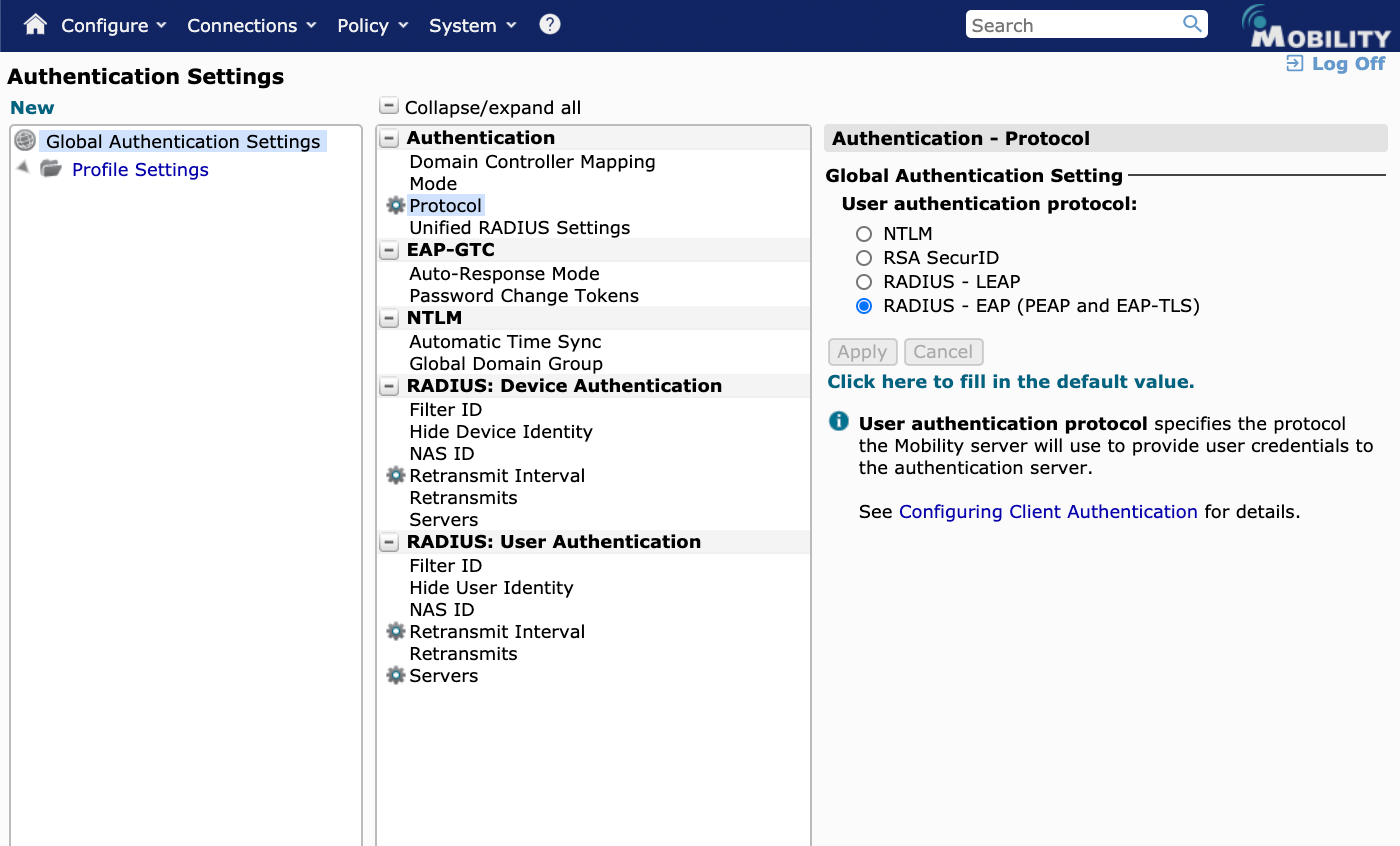
-
Click Apply.
Set RADIUS Retransmit Interval
-
Click the RADIUS: Device Authentication → Retransmit Interval setting.
-
Enter an interval long enough for a user's mobile device to receive and respond to Duo authentication requests. Recommended: at least 40000 milliseconds. If Mobility retransmits an authentication request while the Duo Authentication Proxy is waiting for the second factor it will be detected as an attempt to replay a login already in progress and rejected.
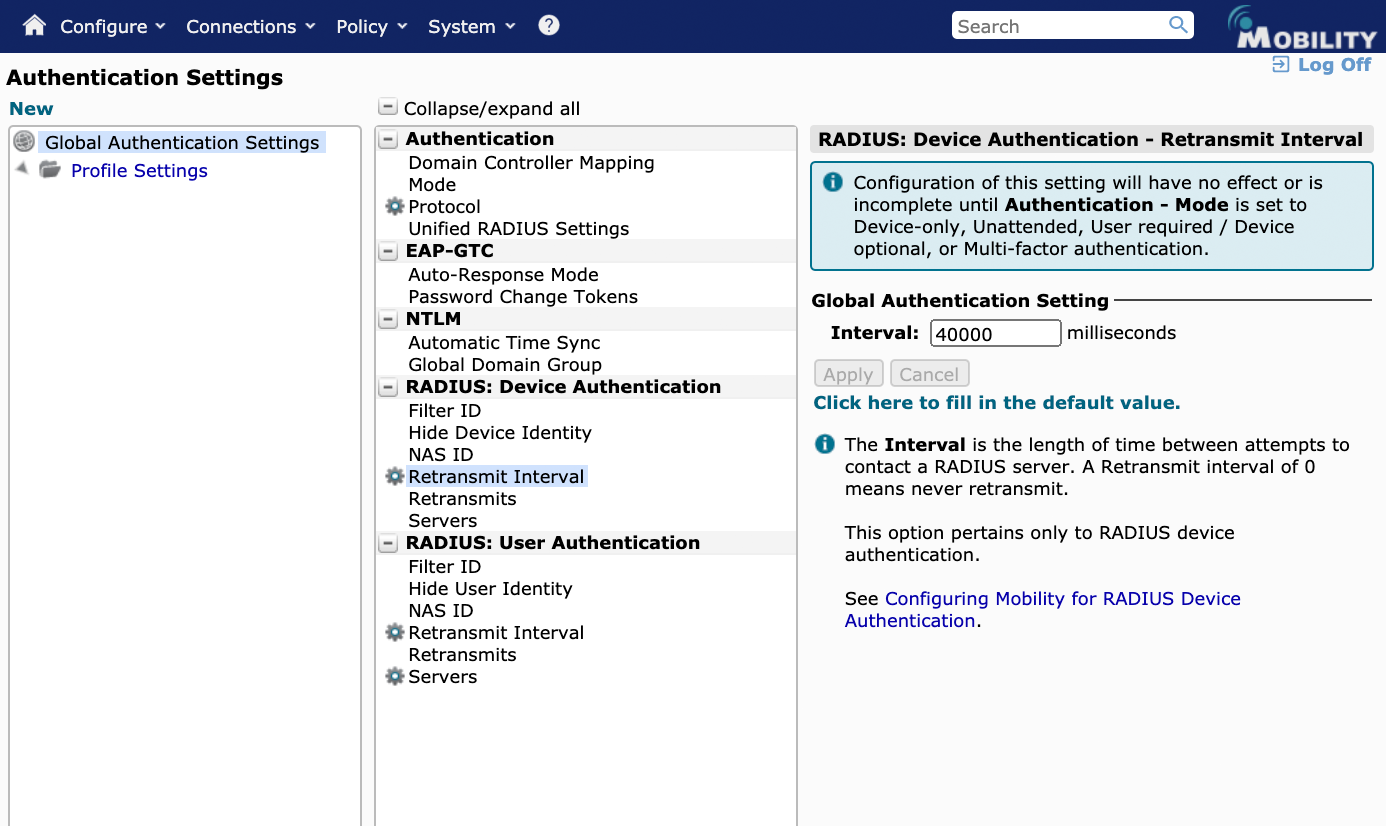
-
Click Apply.
-
Click the RADIUS: User Authentication → Retransmit Interval setting.
-
Change this to the same value you used for the RADIUS: Device Authentication → Retransmit Interval setting Recommended: at least 40000 milliseconds.
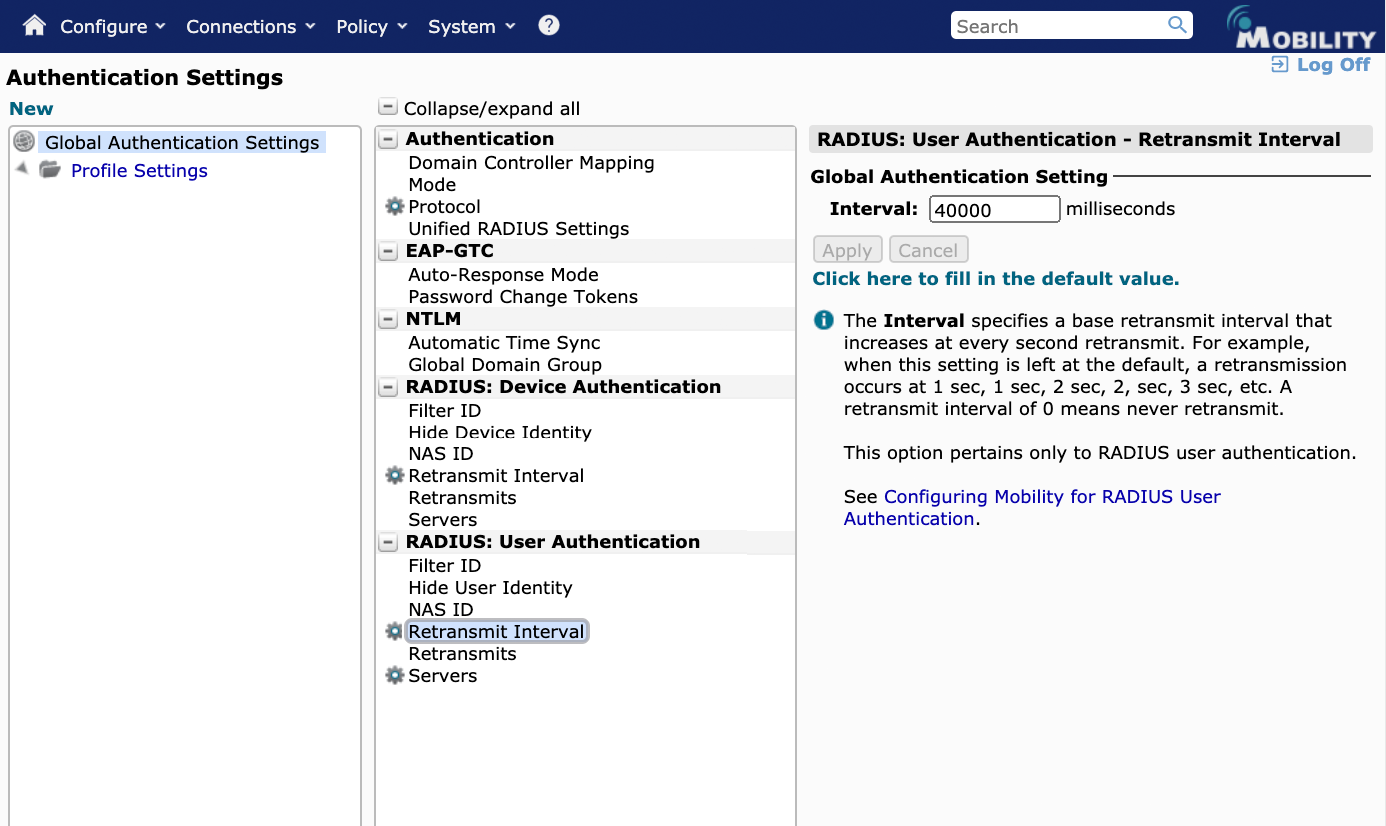
-
Click Apply.
Add RADIUS server
-
Open the RADIUS: User Authentication → Servers setting.
-
Click Add... Enter your Duo Authentication Proxy server's IP address or host name, along with the port and shared secret from the
radius_server_eapsection of yourauthproxy.cfg. Click OK.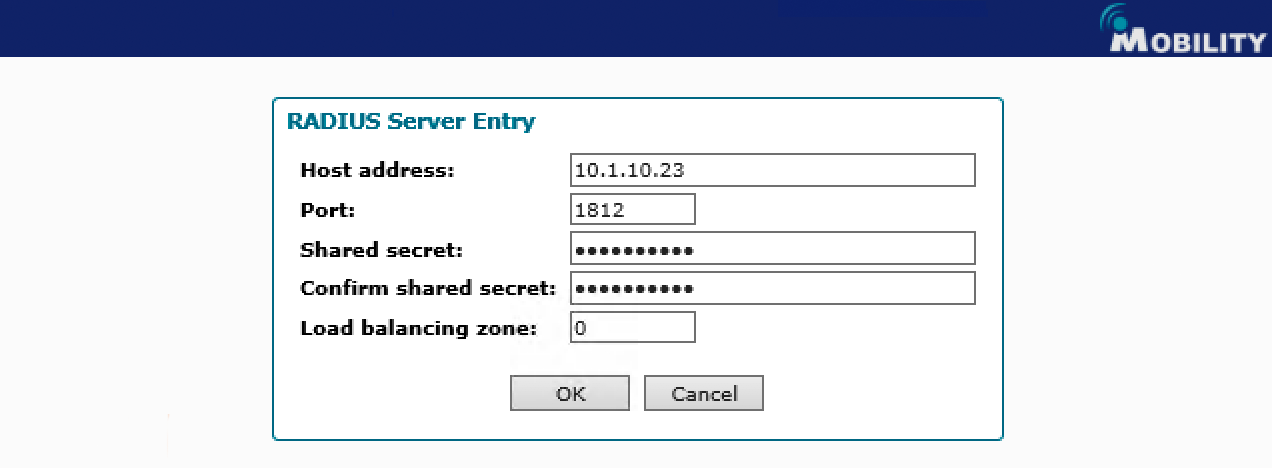
-
Select and Remove any other RADIUS servers from the list to ensure that Duo authentication is always used.
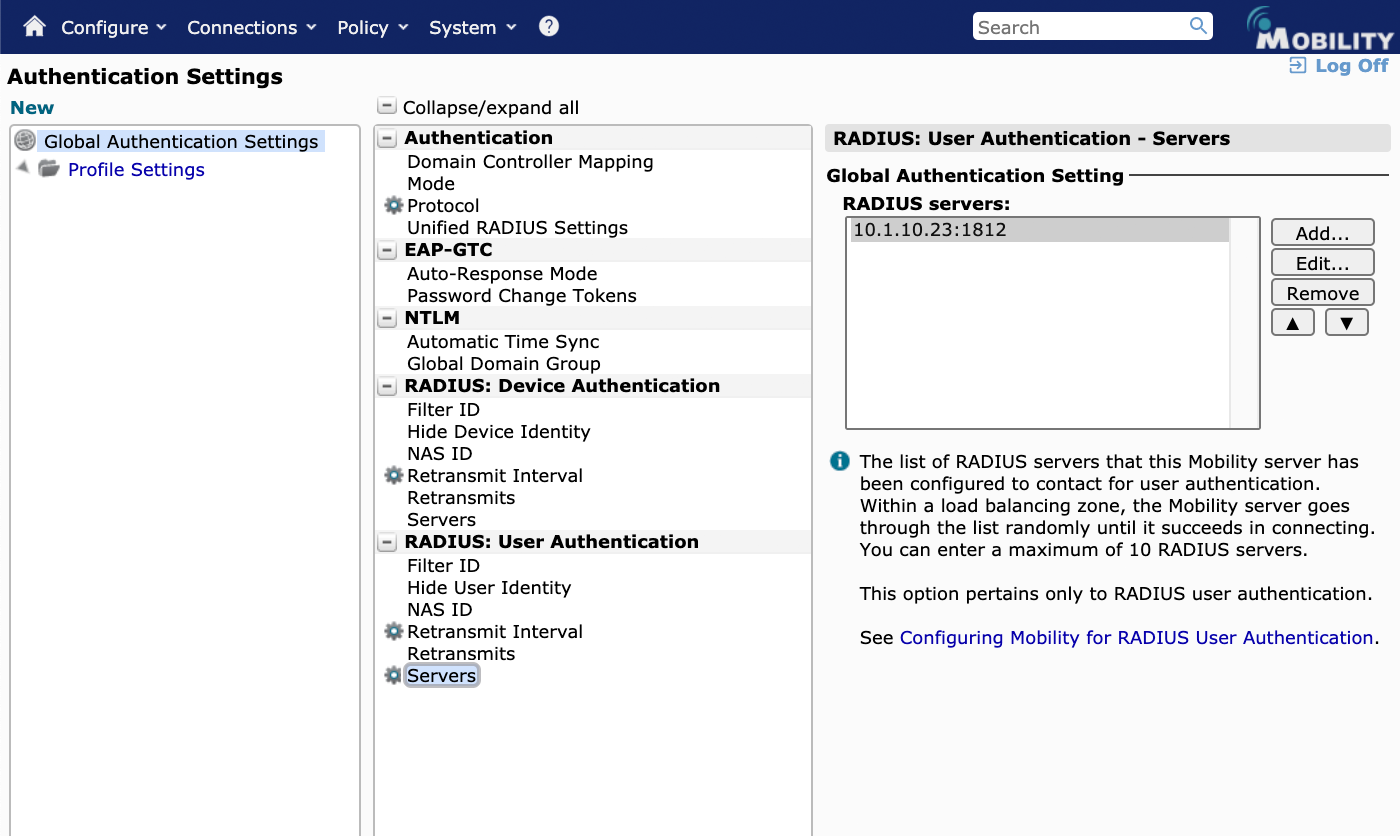
Test Your Setup
-
Launch the Mobility client and log in with your username and password as you normally would.
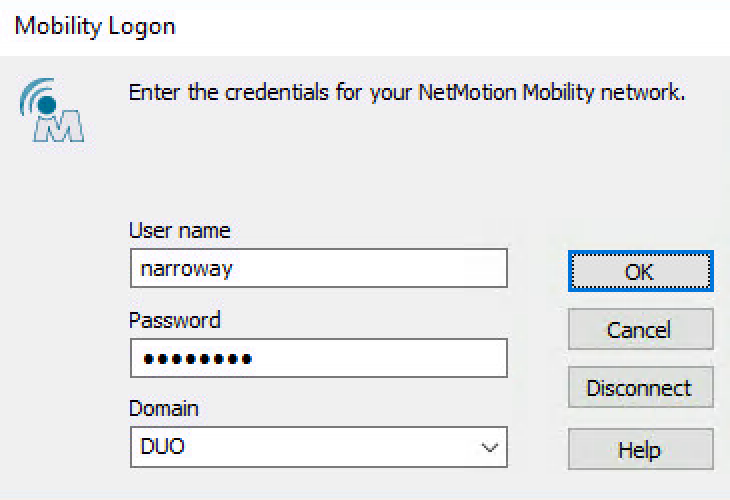
-
Next, enter your Duo passcode or an out-of-band factor into the following prompt and click OK. You may choose from the following factor names:
Factor Description push Perform Duo Push authentication
You can use Duo Push if you've installed Duo Mobile and activated your account.phone Perform phone callback authentication sms Send a new batch of SMS passcodes
You will need to disconnect the Mobility client after receiving the passcodes, and then and connect again, When prompted to enter your Duo factor, use one of the newly-delivered passcodes. Depending on your Mobility client configuration, you may or may not need to reenter your primary login information on the second connection.If you have more than one device of any type registered it's identified by the appended number. For example,
push2will send a login request to your second phone,phone3will call your third phone, etc.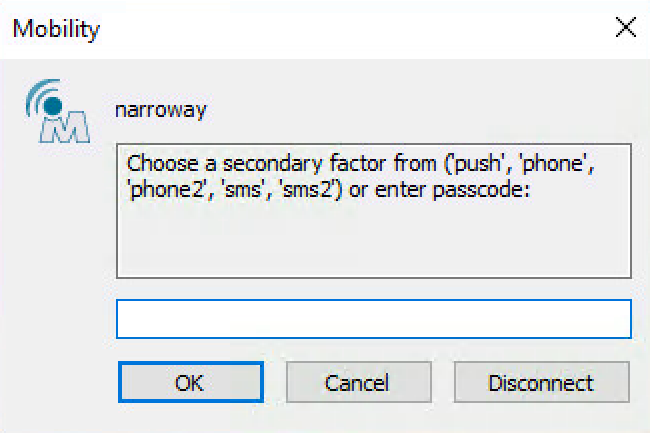
-
Duo will send you a push request, phone call, or SMS message and log you in after you've approved the login request or entered a valid passcode.
Troubleshooting
Need some help? Review troubleshooting tips for the Authentication Proxy and try the connectivity tool included with Duo Authentication Proxy 2.9.0 and later to discover and troubleshoot general connectivity issues.
Also take a look at our NetMotion Knowledge Base articles or Community discussions. For further assistance, contact Support.
Network Diagram
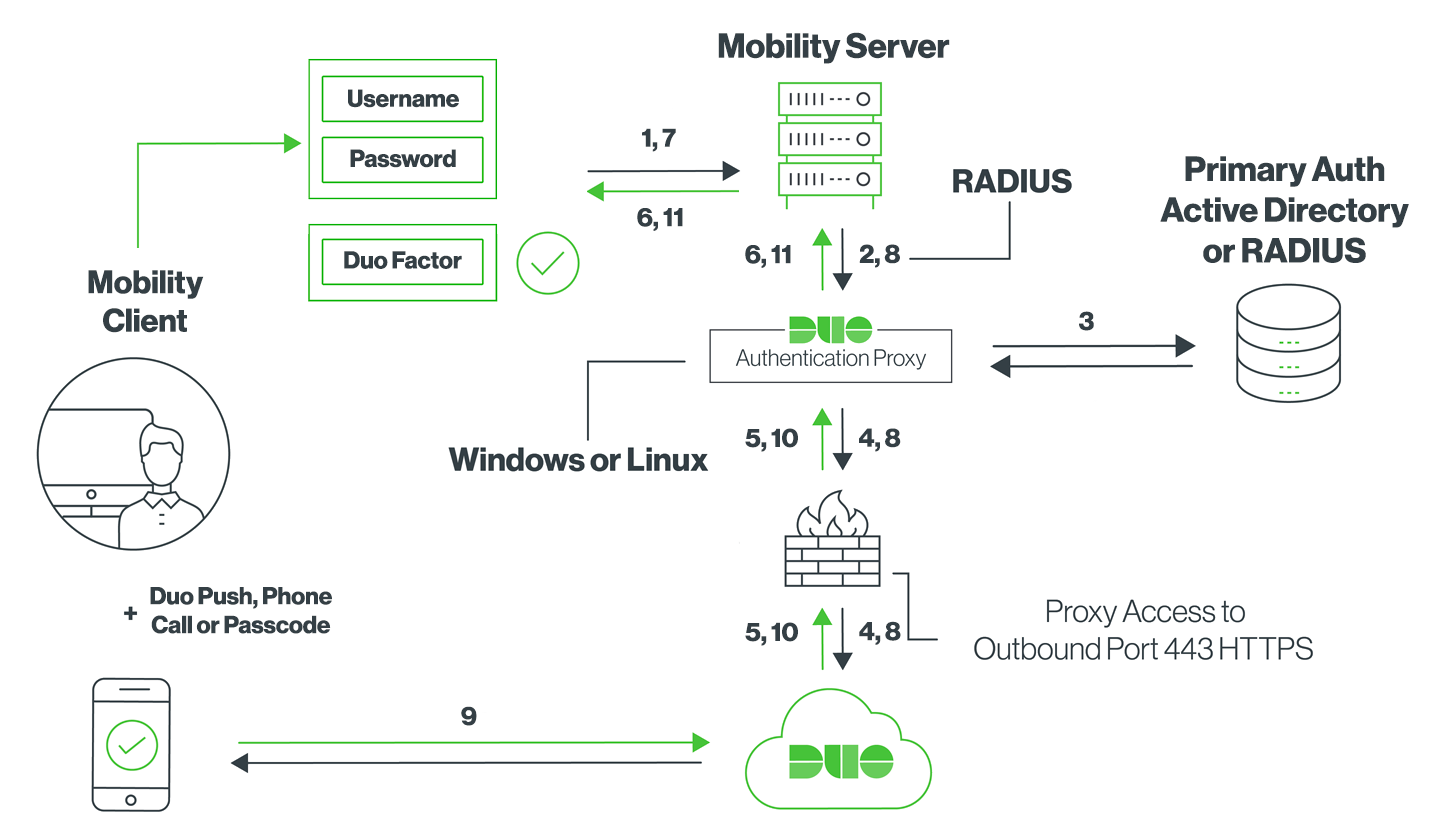
- Primary authentication initiated to NetMotion Mobility
- NetMotion Mobility sends authentication request to Duo Authentication Proxy
- Primary authentication using Active Directory or RADIUS
- Duo Authentication Proxy connection established to Duo Security over TCP port 443
- Duo's service returns available authentication options to the proxy.
- Duo proxy sends authentication options to NetMotion Mobility server as a RADIUS challenge.
- User enters chosen factor when prompted by Mobility client.
- Factor selection sent from Mobility Server to Duo's service via the Authentication Proxy.
- Secondary authentication via Duo Security’s service
- Duo Authentication Proxy receives authentication response
- NetMotion Mobility access granted
